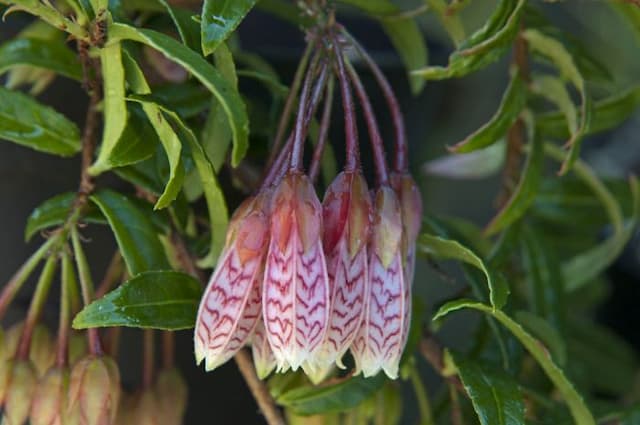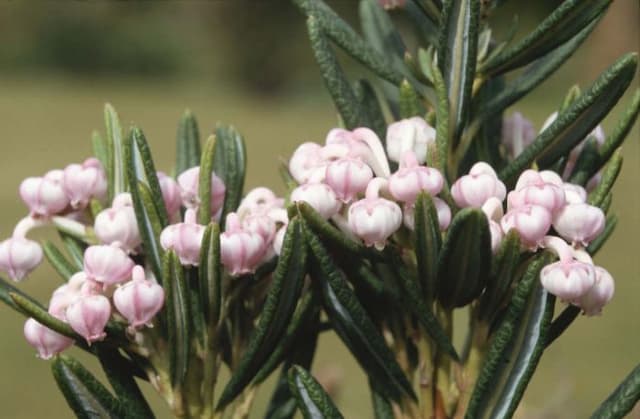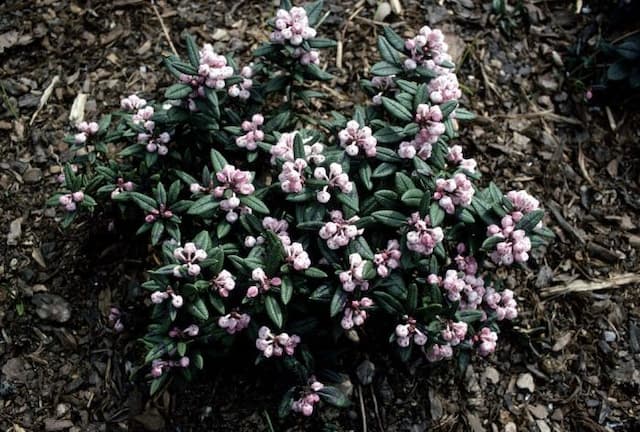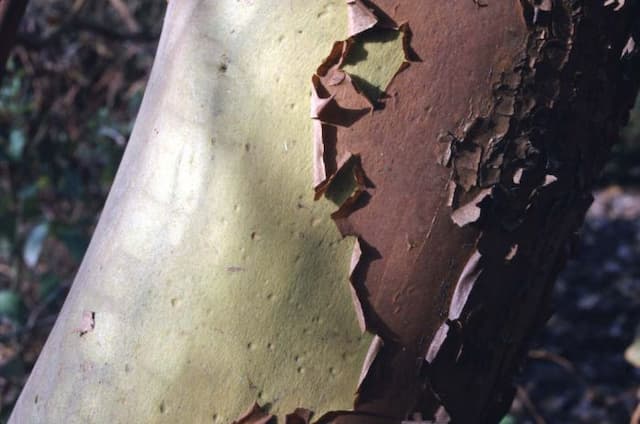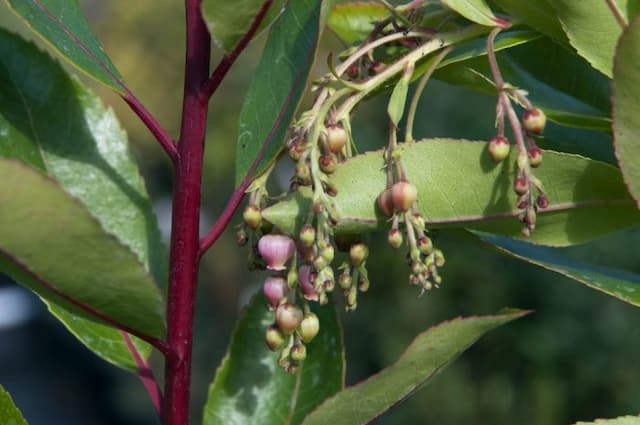Rhododendron Rhododendron 'Marion Street'

ABOUT
The Rhododendron 'Marion Street' is a type of rhododendron known for its attractive blooms and lush foliage. It typically exhibits a dense, shrubby form with an abundance of glossy, dark green leaves that provide a year-round backdrop for its floral display. The leaves are often elliptical in shape with a smooth texture and can have a leathery feel. The flowers are the most striking feature of the 'Marion Street' rhododendron. They generally boast a vibrant color, often shades of pink, red, or purple, which adds a vivid pop to gardens when they are in bloom. Each flower cluster, or truss, comprises multiple individual blossoms that create a rounded, full appearance. These blossoms feature a tubular base that flares open to a wide, bell-shaped flower with five petals, sometimes displaying speckles or variations in hue toward the throat. The overall effect during the blooming season is a spectacular burst of color that stands out against the greenery. Additionally, this plant may occasionally produce seed capsules after the flowering period, which are oblong and dry when mature. The 'Marion Street' is appreciated for its ornamental qualities and is commonly used in landscape settings for its visual appeal.
About this plant
 Names
NamesSynonyms
Rhododendron, Azalea.
Common names
Rhododendron 'Marion Street'
 Toxicity
ToxicityTo humans
The Rhododendron is toxic to humans. All parts of the rhododendron plant contain toxins, but the highest concentration is found in the leaves. If ingested, the plant can cause several symptoms including but not limited to nausea, vomiting, drooling, diarrhea, lethargy, weakness, and abnormal heart rhythm. In severe cases, coma or death may occur. It is important to seek medical attention immediately if ingestion is suspected.
To pets
The Rhododendron is also toxic to pets. Similar to its effects on humans, all parts of the plant are poisonous to animals. If a pet ingests rhododendron, they may exhibit symptoms such as vomiting, diarrhea, drooling, weakness, incoordination, and in severe cases, seizures or coma. Consumption of rhododendron can lead to potentially fatal heart arrhythmias in pets as well. Immediate veterinary care is crucial if a pet is suspected of ingesting any part of a rhododendron plant.
 Characteristics
CharacteristicsLife cycle
Perennials
Foliage type
Evergreen
Color of leaves
Green
Flower color
Pink
Height
4-6 feet (1.2-1.8 meters)
Spread
4-6 feet (1.2-1.8 meters)
Plant type
Shrub
Hardiness zones
5-8
Native area
Asia
Benefits
 General Benefits
General Benefits- Aesthetic Appeal: Adds vibrant color and visual interest to gardens with its striking flowers.
- Attracts Wildlife: Invites pollinators like bees and butterflies, enhancing biodiversity.
- Low Maintenance: Generally requires minimal care once established, saving time and effort.
- Seasonal Interest: Provides year-round beauty with evergreen foliage and seasonal blooms.
- Versatility: Suits a variety of garden styles, from formal to woodland settings.
- Durability: Adapted to a range of climates, showing resilience in different growing conditions.
 Medical Properties
Medical PropertiesThis plant is not used for medical purposes.
 Air-purifying Qualities
Air-purifying QualitiesThis plant is not specifically known for air purifying qualities.
 Other Uses
Other Uses- Rhododendrons can be used in floral arrangements for a short-term splash of color and structure due to their large, bright blooms and bold foliage.
- The leathery leaves of rhododendrons can serve as a natural mulch, providing a protective layer that conserves soil moisture and prevents weed growth.
- The extract from rhododendron leaves can be utilized as a natural dye for fabric, producing surprising shades of brown and yellow.
- Rhododendrons are frequently used in bonsai culture, prized for their ability to be shaped into miniature tree forms that can live for many years.
- Fine wood from mature rhododendron plants can be crafted into small pieces of furniture or artistic woodwork, emphasizing unique grain patterns.
- Rhododendron petals can be used to create colorful, biodegradable confetti for outdoor celebrations, reducing the environmental impact of traditional plastic confetti.
- In some cultures, rhododendron flowers are used in culinary recipes, such as in creating syrups or jellies, but one must be cautious due to their potential toxicity.
- Dense rhododendron thickets provide excellent shelter for wildlife, creating natural habitats for birds and small mammals in gardens and landscapes.
- Dried rhododendron wood makes interesting and decoratively twisted natural walking sticks or can be used in intricate carving projects.
- Rhododendron sap has occasionally been used as a natural adhesive in small-scale, traditional craft applications.
Interesting Facts
 Feng Shui
Feng ShuiThe Rhododendron is not used in Feng Shui practice.
 Zodiac Sign Compitability
Zodiac Sign CompitabilityThe Rhododendron is not used in astrology practice.
 Plant Symbolism
Plant Symbolism- Caution: Rhododendrons are often associated with caution due to their toxic nature, which serves as a reminder to be wary of things that seem alluring but might be harmful.
- Elegance: Rhododendrons, including the 'Marion Street' variety, are known for their beautiful flowers, which symbolize elegance and sophistication.
- Abundance: With their lush, full blooms, they often symbolize abundance and wealth.
- Temperance: The evergreen nature of many rhododendrons, including 'Marion Street', represents moderation and restraint.
- Homecoming: In certain cultures, the rhododendron is a symbol of returning home, due to its habit of growing near mountainous regions where travelers would often pass.
 Water
WaterRhododendrons, including 'Marion Street', should be watered thoroughly, ensuring the entire root zone is moistened. They prefer consistently moist soil, so it's generally best to water them once a week with about 1 inch of water per session. However, during hot or dry weather, you might need to water them twice a week. These plants do not tolerate drought well, so monitor the soil moisture level regularly. It's essential to avoid overwatering, as this can lead to root rot, so if the soil is still damp from the last watering, it's better to wait another day or two before watering again.
 Light
LightRhododendron 'Marion Street' thrives best in dappled sunlight or partial shade. The ideal spot is under the canopy of tall trees that provide filtered sunlight, protecting the plant from the intense direct afternoon sun. Morning sun with afternoon shade is also a preferable condition for optimal growth.
 Temperature
TemperatureThe Rhododendron 'Marion Street' performs best in temperatures that range from 40 to 70 degrees Fahrenheit. They can survive temperatures as low as 20 degrees Fahrenheit but should be protected from harsh winter winds. Ideal growth temperatures are part of the moderate climates where summer temperatures do not exceed 85 degrees Fahrenheit.
 Pruning
PruningPrune the Rhododendron 'Marion Street' to maintain shape and promote vigorous growth, focusing on removing dead or diseased wood. The best time for pruning is shortly after the blossoms have faded, which prevents the removal of next season's buds. Generally, rhododendrons require minimal pruning, and occasional thinning may be necessary to encourage airflow within the plant.
 Cleaning
CleaningAs needed
 Soil
SoilThe best soil mix for Rhododendron (also known as Azalea) 'Marion Street' should be well-draining, moisture-retentive, and high in organic matter. A mix of equal parts peat moss, pine bark, and perlite or coarse sand is ideal. Rhododendrons prefer acidic soils with a pH between 4.5 and 6.0.
 Repotting
RepottingRhododendrons, including the 'Marion Street' variety, should generally be repotted every 2 to 3 years to refresh the soil and to accommodate the growth of the plant. However, they prefer to be slightly root-bound, so repotting should be done carefully.
 Humidity & Misting
Humidity & MistingRhododendrons, like the 'Marion Street' variety, thrive in moderate to high humidity levels. The ideal humidity range for these plants is around 40% to 60%. Avoid placing them near heat sources or in excessively dry environments.
 Suitable locations
Suitable locationsIndoor
Place Rhododendron 'Marion Street' in a bright, indirect light spot with good moisture.
Outdoor
Plant Rhododendron 'Marion Street' in dappled shade with moist, well-drained soil.
Hardiness zone
5-9 USDA
 Life cycle
Life cycleThe life of the Rhododendron 'Marion Street', commonly known as Azalea, begins with seed germination, which occurs under the right conditions of warmth and moisture, often in spring or early summer. Following germination, seedlings establish themselves, developing a root system and foliage through photosynthesis. As the plant matures into a shrub, it enters a vegetative state where it experiences growth in leaves, stems, and roots. Azaleas typically bloom in the spring, producing vibrant flowers that attract pollinators, a critical phase for sexual reproduction. After pollination, seeds form within the flowers, which will disperse for propagation when mature. Finally, the plant reaches the dormant period in the winter months, reducing metabolic activity until conditions are favorable for the next cycle of growth and blooming.
 Propogation
PropogationPropogation time
Early spring
The most popular method of propagating a Rhododendron 'Marion Street', commonly known as a Rhododendron, is through semi-hardwood cuttings. This is typically done during the late summer. To propagate, a cutting of about 4 to 6 inches (10 to 15 centimeters) is taken from a healthy, non-flowering branch. The lower leaves of the cutting are removed, and the cut end is dipped in rooting hormone to encourage root development. The treated cutting is then inserted into a pot filled with a mixture of peat and perlite or a fine rooting medium to provide the right balance of drainage and moisture retention. The cutting needs to be kept under high humidity and indirect light until roots develop, which can take several weeks to months. Regular misting can help maintain the necessary humidity levels.
